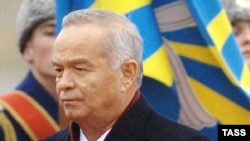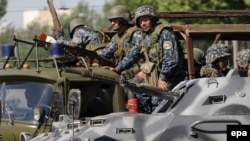The blackest event in the history of Uzbekistan since it became an independent country occurred on May 13, 2005, in the eastern city of Andijon.
Some call what happened that day a massacre, and the violence that occurred has come to define the character of Uzbekistan's government for many around the world.
Every anniversary since has been marked with justified criticism from international rights groups about the Uzbek government's decision to use deadly and disproportionate force in Andijon, and also with articles, like this one, looking back at those dark events.
But as the years have passed, a narrative has developed that at times embellishes some facts and omits key pieces of information that are necessary to keep in mind.
I was following the events that led up to Andijon. I was at work the day the violence broke out and I was in contact with people there in the city, including the insurrectionists. And I remember what happened.
This article in no way attempts to justify the events of 10 years ago but is written in the hope that criticism leveled at Uzbekistan's government for the mass killing in Andijon is accurate and legitimate. Exaggerations are counterproductive.
The Stage Is Set
The leaders of Central Asia were in a panic in April 2005. The problem was not Andijon but Kyrgyzstan, where Kyrgyz President Askar Akaev had just been ousted by a popular revolt. At the time the presidents of Kazakhstan, Turkmenistan, and Uzbekistan had, like Akaev, all been in power since their countries became independent when the Soviet Union collapsed in late 1991. Tajik President Emomali Rahmon was not far behind, having been in power since November 1992.
It was not only that one of the five seemingly invincible Central Asian presidents had been chased from power that unnerved the other four, it was that the revolt that overthrew Akaev was a genuine popular revolt, not organized or controlled by any particular opposition figure or group. The other four Central Asian presidents had spent years neutralizing or eliminating their political opposition but what occurred in Kyrgyzstan was something different.
And Kyrgyzstan was the third former Soviet republic to experience a "colored revolution," after Georgia in 2003 and Ukraine in 2004.
In the months leading up to Andijon, there had been trouble in Uzbekistan's section of the Ferghana Valley. In September 2004, some 100 women staged a sit-in on a main street in Andijon, stopping traffic for an hour to protest the price of raisins at a local bazaar. In November 2004, several thousand people marched through the city of Kokand, some 120 kilometers from Andijon, demanding new regulations for merchants. The group beat up several policemen and burned several police cars.
On May 3, 2005, police staged a violent raid on a camp of protesting farmers outside the U.S. Embassy in Tashkent, beating some of the more than 100 demonstrators, arresting about two dozen, and dragging the others onto buses to be transported out of Tashkent.
Peaceful Protest In Andijon
On May 10, about 100 people turned out in the streets of Andijon to protest the detention of 23 local businessmen. Smaller groups, not well organized, had been doing so since February.
The businessmen were being charged with membership in a banned Islamic group called Akromiya, alleged by Uzbek authorities to be a splinter group of the also banned Islamic group Hizb ut-Tahrir and led by one of the detained businessmen, Akram Yuldashev.
Many doubted the existence of Akromiya. Some locals believed that the recent replacement of Andijon Province's governor, and subsequent shuffle of lower-level provincial officials, had resulted in a change in the local patronage system. Accordingly, the 23 businessmen were paying the price by losing their enterprises to the favorites of the new provincial authorities. President Islam Karimov would partially admit to this several years later.
By May 12, some 2,000 people were attending the demonstration. It was orderly, with benches placed on one side of the street for women to sit on, and men standing on the other side of the street. The demonstrators did not block traffic and they kept the area where they were staging their protest clean. Every day the number of people participating had grown, so May 13, a Friday, looked like it would bring out the biggest crowd yet.
Morning, May 13, 2005
Shortly after midnight on May 13, a group of some 35 armed men -- later described as Islamic extremists -- who had crossed into Uzbekistan from neighboring Kyrgyzstan attacked a police station near Andijon, killing some of the policemen and chasing the others away. The armed group seized weapons from the police station, then went to a prison where they shot their way in and freed more than 2,000 inmates.
The armed men, accompanied by several hundred of the freed inmates, some of whom had acquired weapons after the jailbreak, went to Andijon to join the protest.
As day broke, gunfire started in Andijon. In a short time there were tens of thousands of people out in the streets, an armed group had captured the city administration building, several buildings were on fire, and the police force in the city of more than 300,000 people was nowhere to be seen.
Chaos reigned in Andijon, but the people who had occupied the city administration building, and appeared to be leading the revolt, provided some clarity as they put forth demands that changed as the day went on. One of the leaders, Qabiljon Parpiev, held negotiations over the phone with then-Uzbek Interior Minister Zakir Almatov.
Originally they wanted the immediate release of the 23 businessmen and called for international organizations, such as the UN and OSCE, as well as Russia and the United States to act as mediators in the dispute between the businessmen and the Uzbek authorities.
At least nine people were reported dead and 34 wounded by noon.
Evening, May 13, 2005
By early afternoon there were reports of Uzbek military and Interior Ministry columns advancing on Andijon from every direction. There were tens of thousands of people out in the streets of the city, some caught up in the euphoria of what many were starting to believe was a revolution. There were claims that more than 30,000 people were crammed into Babur Square in the center of Andijon.
Uzbek troops made their way onto rooftops and when they had taken their positions the armored vehicles entered the city. Shooting started immediately and everyone on the street was a target. The soldiers on the rooftops fired down into Babur Square.
The vast majority of the people out in Andijon were unarmed, many were women, children, and the elderly, but troops made no distinction between combatant and civilian and fired at anything that moved. Witnesses said many unarmed people were shot in the back as they were trying to flee.
It was a massacre.
By the time darkness fell, "order" had been restored in Andijon.
Some pockets of resistance held out along the Kyrgyz border but within 48 hours these had been cleared and thousands of Uzbeks had fled into Kyrgyzstan.
Officially, the Uzbek government put the death toll at 187 people, with about one-third being officials and soldiers, another third the "militants," and the last third civilians.
In the days afterward there were dozens of reports of mass graves appearing around Andijon. Some claimed there were cases where three bodies were being put into single graves to hide the number of dead. RFE/RL's Uzbek Service received reports of cargo planes arriving in Andijon and leaving for all regions of Uzbekistan, ferrying bodies to be buried around the country so an accurate count of the dead could never be made.
Nearly every government reacted by agreeing the Uzbek government had the right to keep order, but there was a huge difference about the means used to achieve this goal.
Many who were there that day say hundreds of people and possibly thousands were killed during the early evening of May 13.
-- Bruce Pannier








